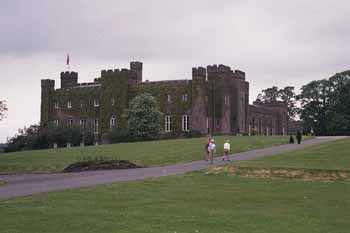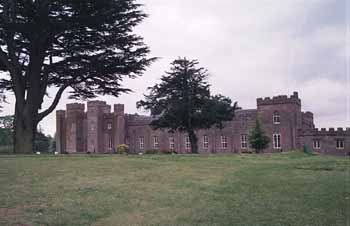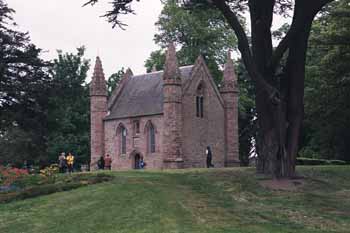
O t h e r S i g h t s
Travelogue Home
Travel Home
Planning
Resource Scotland
Itinerary
Scottish Castles
Abbeys and Kirks
Other sights
|
sights |


The imposing facade of Scone Palace. The vines bloom red in summer
 Scone Palace is historically the heartland of the Scoto-Pictish Kingdom, a legend that was perpetuated by King Kenneth MacAlpine in the mid-9th century, when he made Scone the senter of the kingdom, a counterpart of the recently created ecclesiastical seat in Dunkeld. From this time on, the Scottish kings were crowned on the Stone of Destiny, which MacAlpine brought in 838 from Dunstaffnage. Robert the Bruce was crowned here, and every king through Charles in 1651 was also crowned here. The stone was stolen by Edward I in 1296 and carried off to Westminster, where it's been on the Coronoation Chair ever since. It was returned to Edinburgh Castle in 1996.
Scone Palace is historically the heartland of the Scoto-Pictish Kingdom, a legend that was perpetuated by King Kenneth MacAlpine in the mid-9th century, when he made Scone the senter of the kingdom, a counterpart of the recently created ecclesiastical seat in Dunkeld. From this time on, the Scottish kings were crowned on the Stone of Destiny, which MacAlpine brought in 838 from Dunstaffnage. Robert the Bruce was crowned here, and every king through Charles in 1651 was also crowned here. The stone was stolen by Edward I in 1296 and carried off to Westminster, where it's been on the Coronoation Chair ever since. It was returned to Edinburgh Castle in 1996.
Recently, it was offered to return the Stone of Destiny to its position in Scone Palace. It was refused, lending credence to a rumor/legend that the monks at the palace knew that Edward I was going to steal the stone; they placed a fake stone in its place and hid the real stone until the English soldiers left. Scotland doesn't need the stone from Westminster, since it is a fake and the original never left Scone. Who knows?
The original celtic community in this area was superceded when Alexander I founded an Augustinian Priory here in 1120, the first of that order in Scotland. The priory was colonized by canons from Yorkshire. Like many abbeys, Scone Palace and the abbotts house served as a royal residence during the reign of Robert III 1390-1405.

A view of the palace from the grounds.
The abbey was sacked in 1559 destruction following John Knox's sermon in Perth, and became the property of the Earls of Gowrie, who built a 16th century house here using old palace stones. The estate was bestowed on the Earls of Mansfield in 1600. The 3rd earl commissioned William Atkinson to build a neo-Gothic palatial mansion on the site in 1802-8.
Facing the palace is Moot Hill, now occupied by the 19th century chapel. The name is interesting: The gaelic, Tom-a-mhoid, means aplace where justice would be administered, while the "Boot" version is more incredible but more appealing -- when all the earls, chieftans, and other men of consequence came to swear loyalty to the Lord High Ardh, they carried in their boots earth from their own lands, and piled it here, since they could only swear fealty while standingon their own land. Having taken the oath, they emptied their boots on the spot.

The small chapel at Scone Palace, on the site of Moot Hill